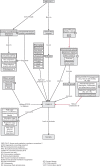A COVID-19 pandemic guideline in evidence-based medicine
- PMID: 32591667
- PMCID: PMC7317259
- DOI: 10.1038/s41432-020-0105-7
A COVID-19 pandemic guideline in evidence-based medicine
Abstract
Data sources This review article scrutinised 16 clinical studies (clinical trials and observational studies) concerning coronavirus disease of 2019 (COVID-19). Additionally, 18 guidelines about the COVID-19 were reviewed and the key points were represented in this study.Study selection The review included human trials, in-vitro studies, review articles, and credible news reports about severe acute respiratory syndrome coronavirus 2 (SARS-CoV-2) and COVID-19 complications, treatment guidelines, management strategies, and epidemiological features. There were no exclusion criteria reported in this review and the included information was in English and Chinese languages.Data extraction and synthesis A descriptive review of the literature was conducted, taking a comprehensive approach. The paper consisted of three main parts: introduction, presentation, and management. The introduction part presented basic information about the SARS-CoV-2, its evolution and transmission, and the course of disease. The presentation section introduced the signs and symptoms, diagnosis, high risk groups, and complications of COVID-19. Eventually, some evidence was presented about the prevention, medical management, and measuring responses to the treatments in the management section.Results Based on the results of this study, non-pharmaceutical interventions, including strict social isolation and distancing measures, might reduce the spread of the SARS-CoV-2 by nearly 99.3 percent (reproduction number mitigating from 406 to 2.5 in 30 days). In the supportive management section, monitoring vital signs and neonatal feeding were stated as the most important factors to consider. For symptomatic neonates, medical management and intervention were mentioned as essential. It was claimed that for adults with mild infection, the best option would be home quarantine with further medical monitoring or hospitalisation if required. The following sequence was also suggested as early supportive therapy and monitoring: intravenous fluid administration, oxygen therapy, and application of corticosteroids. Management of critical patients with critical COVID-19 included admission to intensive care unit, use of continuous positive airway pressure and bi-level positive airway pressure in certain circumstances, endotracheal intubation, invasive mechanical ventilation, extracorporeal membrane oxygenation, and fluid resuscitation and vasopressors. Additionally, this study suggested oseltamivir, iopinavir, remdesivir, chloroquine, baricitinib, ruxolitinib, and fedratinib as possible drugs to help manage COVID-19. A soaring c-reactive protein level and decreased albumin content in the blood were reported to be associated with a deteriorating status in COVID-19 patients. To keep the number of exposures to a minimum, two separate viral clearance tests taken at least 24 hours apart, were stated as necessary laboratory results before the discharge of patients with COVID-19.Conclusions The study warns about possible exponential spread of COVID-19 and proposes to adhering to tighter restrictions of social distancing. Besides the clinical guidelines presented within the study, it also encourages further up-to-date and evidence-based management guidelines for patients with COVID-19.
Comment on
-
Evidence based management guideline for the COVID-19 pandemic - Review article.Int J Surg. 2020 May;77:206-216. doi: 10.1016/j.ijsu.2020.04.001. Epub 2020 Apr 11. Int J Surg. 2020. PMID: 32289472 Free PMC article. Review.
References
-
- Coronavirus Update (Live): 4964032 coronavirus cases; 323483 deaths [Internet]. 2020. Available from: https://www.worldometers.info/coronavirus/ (accessed May 2020).
-
- Network A R D S. Ventilation with lower tidal volumes as compared with traditional tidal volumes for acute lung injury and the acute respiratory distress syndrome. N Engl J Med 2000; 342: 1301-1308. - PubMed
-
- WHO. Clinical management of severe acute respiratory infection when novel coronavirus (nCoV) infection is suspected: interim guidance, 25 January 2020. World Health Organization; 2020.
Publication types
MeSH terms
LinkOut - more resources
Full Text Sources
Research Materials
Miscellaneous



